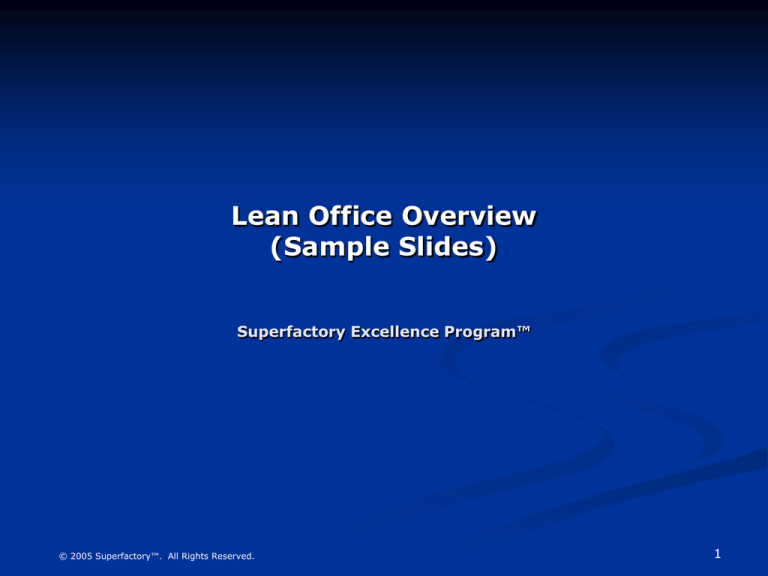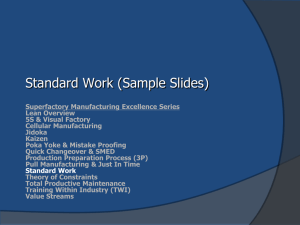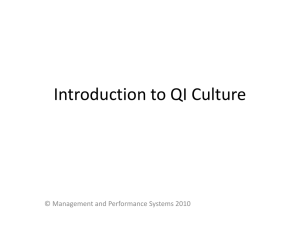
Lean Office Overview
(Sample Slides)
Superfactory Excellence Program™
© 2005 Superfactory™. All Rights Reserved.
1
Outline
1.
2.
3.
4.
5.
6.
7.
8.
9.
10.
11.
What is Lean?
5S & Visual Controls
Kaizen
Value Streams
Pull Manufacturing
Mistake Proofing
Quick Changeover
Six Sigma
Lean Accounting
Theory of Constraints
Human Factors
© 2005 Superfactory™. All Rights Reserved.
2
Thinking Lean
Specify value
can only be defined by the ultimate customer
Identify the value stream
exposes the enormous amounts of waste
Create flow
reduce batch size and WIP
Let the customer pull product through the value stream
make only what the customer has ordered
Seek perfection
continuously improve quality and eliminate waste
From Lean Thinking by Womack and Jones
© 2005 Superfactory™. All Rights Reserved.
3
Benefits
Lean provides tangible benefits
Reduces costs not just selling price
Reduces delivery time, cycle time, set-up time
Eliminates waste
Seeks continuous improvement
Improves quality
Improves customer ratings and perceptions
Increases overall customer satisfaction
Improves employee involvement, morale, and company
culture
Helps “transform” organizations
© 2005 Superfactory™. All Rights Reserved.
4
Toyota Production System (TPS)
Quality, Cost, Delivery
Shorten Production Flow by Eliminating Waste
Just In Time
The Right Part at the Right Time in the Right Amount
Continuous Flow
Pull Systems
Level Production
Built-In Quality
Error Proofing – Poka Yoke
Visual Controls
Operational Stability
Standardized Work
Robust Products & Processes
Total Productive Maintenance
Supplier Involvement
© 2005 Superfactory™. All Rights Reserved.
5
Eight Service Industry Wastes
1.
2.
3.
4.
5.
6.
7.
8.
Errors in documents
Transport of documents
Doing unnecessary work not requested
Waiting for the next process step
Process of getting approvals
Unnecessary motions
Backlog in work queues
Underutilized employees
© 2005 Superfactory™. All Rights Reserved.
6
Examples of Office Process Waste
•Too many signature levels
•Unclear job descriptions
• Obsolete databases/files/folders
• Purchase Orders not matching quotation
• Errors – typo’s, misspelling, wrong data
• Waiting – for information, at meetings, etc.
• Poor office layout
• Unnecessary E-mails
© 2005 Superfactory™. All Rights Reserved.
7
Lean vs. Traditional
Major reduction in sales-order cycle time by 59 percent
(from 23 hours to 9 hours)
Engineering change-order cycle time by 91 percent
(from two hours to two)
Response time to customer’s quote requests by 83
percent (from 66 hours to 11 hours)
Errors by company employees were reduced by 69
percent
(Tonya, 2004)
© 2005 Superfactory™. All Rights Reserved.
8
After 5S
Clear, shiny aisles
Color-coded areas
Slogans & banners
No work in process
© 2005 Superfactory™. All Rights Reserved.
9
Push Vs. Pull Scheduling
Push Scheduling
• traditional approach
• “move the job on when finished”
• problems - creates excessive inventory
Pull scheduling
• coordinated
• driven by demand (pulled through system)
• extensive use of visual triggers
(production/withdrawal kanbans)
© 2005 Superfactory™. All Rights Reserved.
10
Everyday Poka Yoke Examples
3.5 inch diskettes cannot be inserted unless diskette
is oriented correctly. This is as far as a disk can be
inserted upside-down. The beveled corner of the
diskette along with the fact that the diskette is not
square, prohibit incorrect orientation.
Fueling area of car has three error-proofing devices:
1. insert keeps leaded-fuel nozzle from being inserted
2. tether does not allow loss of gas cap
3. gas cap has ratchet to signal proper tightness and
prevent overtightening.
New lawn mowers are required to have a safety bar
on the handle that must be pulled back in order to
start the engine. If you let go
of the safety bar, the mower blade stops in 3
seconds or less.
© 2005 Superfactory™. All Rights Reserved.
11
Six Sigma as a Metric
Sigma = = Deviation
( Square root of variance )
7
6
5
4
3
2
1
0
-1
-2
-3
-4
-5
-6
-7
Axis graduated in Sigma
between + / - 1
68.27 %
between + / - 2
95.45 %
45500 ppm
between + / - 3
99.73 %
2700 ppm
between + / - 4
99.9937 %
63 ppm
between + / - 5
99.999943 %
0.57 ppm
between + / - 6
99.9999998 %
0.002 ppm
© 2005 Superfactory™. All Rights Reserved.
result: 317300 ppm outside
(deviation)
12
Constraints
Any system can produce only as much as its critically constrained
resource
Constraint
60 units
Per day
70 units
Per day
40 units
Per day
60 units
Per day
Maximum Throughput = 40 units per day
© 2005 Superfactory™. All Rights Reserved.
13










